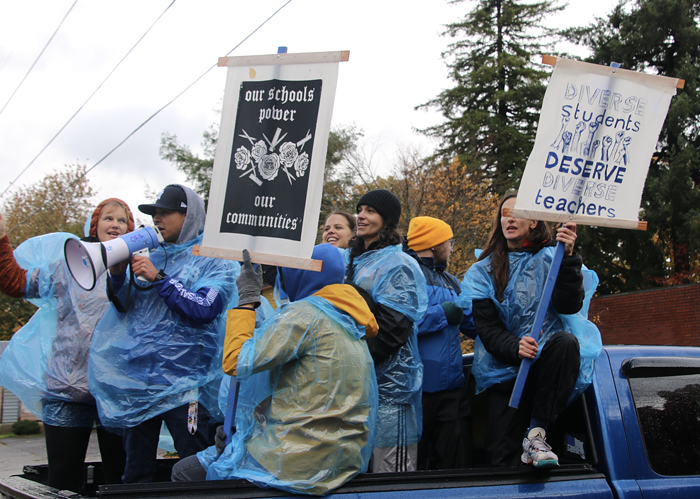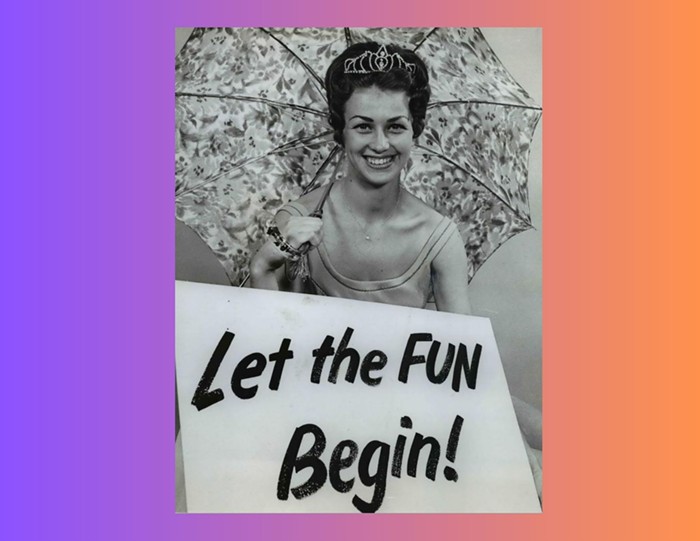"I think this is a typical agroglyph," he says with the air of an archeologist. "It looks real."
Together with some friends, Lewis has come to investigate reports of an anomalous formation in a field outside Forest Grove. He seems to be struggling with which line to take: Is it real or a hoax?
"There's no hole here," he says pointing to the middle of the circle. "What they'd probably have to do is put a broom stick there or something, and do a complete sweep around, but I don't see a hole. That's the only way I can see they could have put it together."
That is the professional opinion of the self-described "talk show host/journalist" and Portland's nearest incarnation of Fox Mulder. On his radio program, "Ground Zero," he frequently totters between reason and belief while discussing everything from aliens to chupacabras to government mind control, with guests that include everyone "from crackpots to weirdoes."
Now we will be discussing crop circles.
The flattened wheat is arranged in a complex design that gives an eerie effect and raises strange questions. Is this where the ship landed? Was there a rift in the space-time fabric? Is it some undecoded message from another planet? Or did the new Mel Gibson movie, Signs, give local kids ideas?
Mel Gibson he's not, but Clyde Lewis--mullet and all--is in fact a movie star. He has three horror films to his credit, including Nightfall, Cage In Box Elder, and most famously, a starring role as the hero's voice in Citizen Toxie: The Toxic Avenger 4.
Now, though, he focuses mainly on his radio show, which he started in Utah, and has continued doing since moving to Portland in 1999. He says he was the first one to synchronize The Wizard of Oz and Pink Floyd's Dark Side of the Moon. He was also a Mormon missionary in Argentina, where he met voodoo priests, satanists, witches, communists, and Muslims. The experience blew him open.
"It just expanded my horizons," he says, "to the point where I felt like I was cheating myself out of experiencing other people's beliefs." When he came back, he quit the Mormon church and has been experiencing other people's beliefs ever since.
Lewis crouches down to the earth. "This is what I find interesting," he says gently touching the wheat. "How they're bent. I don't know if they're bent or broken, but they're bent they're bent well."
A first-grader could tell you that all the wheat shafts are broken, snapped clean at the base, which is a dead giveaway that bored teenagers were out here with two-by-fours and ropes in the middle of the night. In "real" circles, according to most researchers, the shafts are bent and unharmed, and the plants keep growing across the ground. There is also allegedly an electromagnetic distortion that makes compasses spin.
"My mind isn't linear enough to figure something like this out," Lewis says, hinting at the enormity of the task, "but I'm sure there are people who could."
Though down the totem pole from Art Bell and Jeff Rense, Clyde Lewis does consider himself a serious researcher. This investigation consists mainly of standing around, spouting off hunches and theories and bits of hearsay cobbled together from the internet. Other Ground Zero investigations have delved into things like, "Alien Sun Gods and the Icarus Theory," "Baalzebub: The Great Watcher in the Wings" and "Project Homunculus: Preparing for the Alien War."
In his search for the truth, Clyde Lewis has left no stone unturned.
But Lewis is no mere wallflower at the paranormal party either. He claims to have been visited by the legendary "Men in Black." (They bombed his car in 1996 "to scare him.") He is haunted by demons. He is plagued by the numbers 222 and 444 (and sometimes 23). And he boasts of an uncanny knack for happening into news, like the time he sat next to a British man on a plane, who told him the royal family were incestuous, blood-sucking reptilians, engaged in a conspiracy to rule the world (again). This led him to a devastating conclusion.
"I have determined," Lewis says, "that Prince William has every chance of being the Anti-Christ."
Clyde Lewis also has three ex-wives.
WHERE CROP CIRCLES COME FROM
Yet, in spite of his trafficking in all things wacky, the Forest Grove circle is only the second "glyph" he's ever been to. The first was in Logan, Utah, where he saw a blind girl in the circle's center, playing the violin because she heard angels.
At the Forest Grove glyph, he seems reluctant to relinquish the mystery. (He's got to have something for his show tomorrow night). His own theory about the circle seems a bit muddled. "I have a belief," he says, "that the real ones happen because of tremors in the ground causing the crops to flatten. There are a lot of elements that have to happen where " He trails off, and goes over to where someone has found some odd imprints in the wheat.
Yet there is no shortage of theories among those at the circle. It could have been caused by: a) water somehow running clockwise; b) a funnel cloud that was in the area the day before; c) some sort of electrostatic effect; d) eddies in the electromagnetic field; e) aliens; f) kids.
But there is no way to test these hypotheses, so we're left to our hunches.
Which is the beauty of crop circles: You can think what you want about them. They grow in a muddy field of pseudoscience, are watered by myth, and are fertilized with belief. And many of those beliefs have built up over the last decade in a frenzy surrounding the formations. Each year, as the circles seemed to grow more intricate and complex, the temptation to attribute intelligence to them became too much, especially as the millennium approached. It was an orgy of speculation that swept even Led Zeppelin away.
The end was coming and the wheat was trying to tell us something.
Then last year, the voice of doom (reason) spoke, demolishing these fantasies. Colin Andrews, the guru of "cereology," the captain of croppies, made an announcement that shocked believers across the world. Andrews said he'd been faced with undeniable evidence that many of the circles he had researched, in fact most (in fact 80%) were made--by people. All those beautiful, meaningful messages from above were the creations of homo pranksterius.
In other words, they were fakes.
There was a little silver lining for the faithful, though. Andrew said the other 20% of simple circles were likely formed by some kind of electromagnetic eddy. In many of these, he claimed to detect an electromagnetic signature that did not exist in the elaborate ones.
To this day, many refuse to believe him and cling to their convictions. But soon enough, they will be faced with a new onslaught of intelligently designed circles. Because, as the world watches Mel Gibson run around Pennsylvania, worrying about Armageddon, the percent of man-made glyphs are likely only to increase.
But then again, does it matter who makes them?
John Lundburg, who runs the "Circle Makers" website, thinks not. He and his partner have been making "crop art" in Southern England for 10 years now. They see crop circles as a legitimate creative medium, and are cagey about speculating on circles that aren't their own.
"As for the others," Lundburg says, "I don't care if aliens, or the wind, or earth energies, or hedgehogs, or multidimensional beings from the future are out making them as well, as long as they take the time to create well executed original designs."
For him, these elaborate pictograms are not fake anythings. They are real works of art that tell us much about ourselves. "At the end of the day," Lundberg says, "crop circles could be viewed as huge ink-blot tests writ large in the fields. They reflect back the hopes, fears, and beliefs of those who view them. People will believe what they want to believe."
A WORLD BIGGER THAN US
What Clyde Lewis appears to want to believe is there were circular tremors in the night under Forest Grove, or perhaps there was some electrostatic whirlwind. But as evidence of these fails to materialize, he grasps for a sentiment similar to Lundburg's.
"It doesn't matter if aliens make them or not," he says, in a kind of exasperation. "The truth is that they're made. And why are they made?"
Which brings us back to where we started. But basically what Lewis is saying is that we can't write off all the other possibilities. Basically, he wants to believe crop circles hint at a wider world, and there are still mysteries not explained by physics and biology and chemistry. He wants to believe in a cosmic puzzle yet to be solved.
Clyde Lewis wants to believe the world is bigger than us.
But Clyde Lewis also wants to believe he's a serious investigator, an objective journalist carefully weighing the facts. And because of this, he eventually concedes to the less sexy argument. Besides, some locals stopped by and said they knew the kids who did it.
"Well," says Lewis, trying to salvage the anticlimax, "it's definitely a unique circle. It's kind of fun."
And with that, he shrugs and heads through the rustling wheat back up to the road.
For now, at least, the case is closed.


















